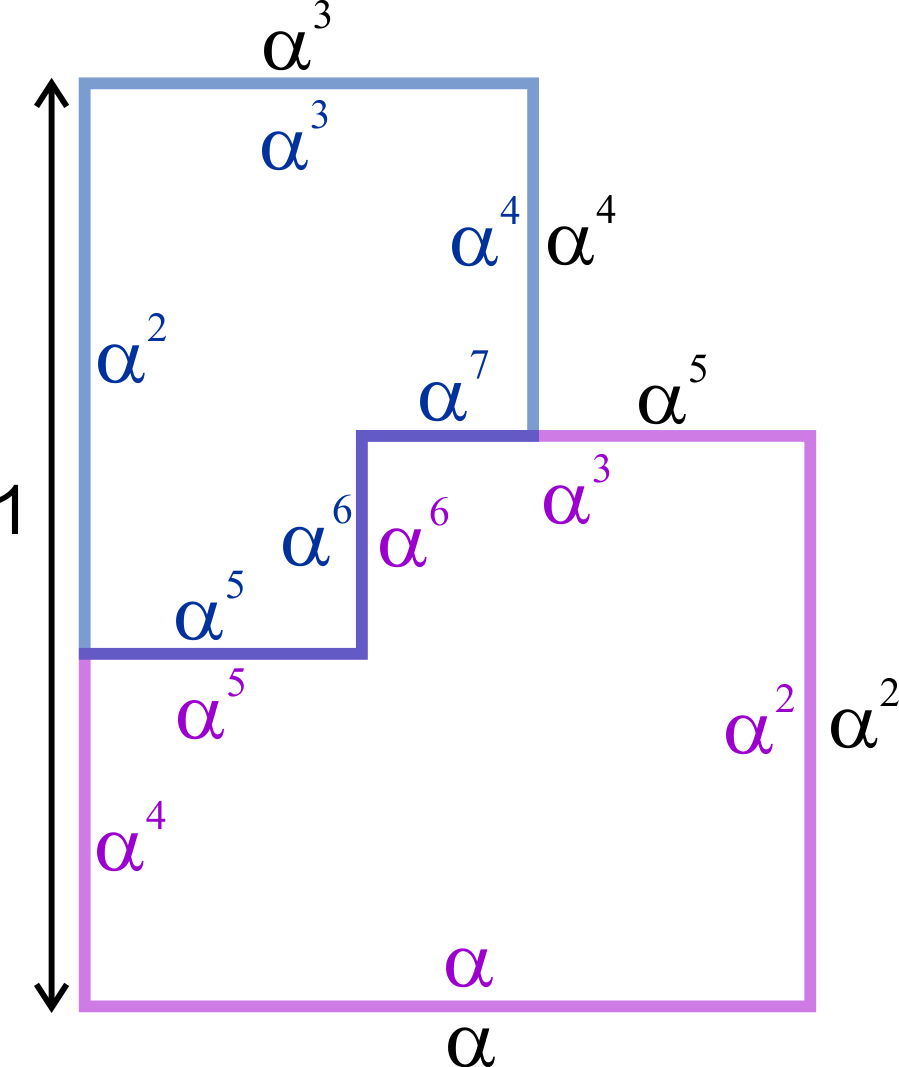3. Why is the Golden b ‘golden’?
The Golden b shape has the golden ratio (`phi = (1 + sqrt(5))/2`) embedded into its size and shape. To find out where, let’s start by examining two interlocking Golden b tiles:

One of the properties of the Golden b is that the length of each side is just the length of the next longest side multiplied by a constant factor. Let’s call this factor `alpha`, and assume for the moment that we don’t know what it is.
In the diagram above, we’ve given the longest side of the combined b-shape a length of 1. That means the second-longest side of the combined b (i.e. the longest edge of the purple b-tile) will have a length of `1 * alpha = alpha`.
Following this same pattern, the second-longest edge of the purple tile is simply the longest edge of the purple tile multiplied by `alpha`, or `alpha * alpha = alpha^2`.
The next shortest side is `alpha * alpha^2 = alpha^3`.
And so on, all the way down to the shortest side of the purple tile, which has a length of `alpha^6`.
This shortest side of the purple tile is the same size as the second-shortest side of the smaller blue tile. Therefore, the second-shortest side of the blue tile is also `alpha^6` long.
That means the shortest side of the blue b-tile is `alpha^7` long, and the third-shortest side is `alpha^5`. Following this process, we discover that the longest side of the blue tile is `alpha^2`.
Now, because the longest side of the combined b has a length of 1, we know that:
`alpha^4 + alpha^2 = 1`
This is actually a quadratic equation we can use to find the value of `alpha`.
If we let `x = alpha^2`, we can rewrite the equation as:
`x^2 + x -1 = 0`
We can then solve this for x using the quadratic formula:
`x=(-b +- sqrt(b^2-4ac))/(2a)`, with `a = 1`, `b = 1` and `c = -1`.
This formula gives us the solutions:
`x= (+-sqrt(5)-1)/2`
We ignore the solution that would give us a negative value for x, and stick with:
`x= (sqrt(5)-1)/2`
You might notice that this is very similar to the value of the golden ratio: `phi = (1 + sqrt(5))/2`.
By multiplying the top and bottom of our solution by `(sqrt(5)+1)`, we get:
`x=((sqrt(5)-1)(sqrt(5)+1))/(2(sqrt(5)+1))`
And because `(sqrt(5)-1)(sqrt(5)+1)=5-1=4`, we can simplify this to:
`x = 4/(2(sqrt(5)+1))`
And then to:
`x = 2/((sqrt(5)+1))`, which is the same as `1/phi`, where `phi` is the golden ratio!
Remembering that `x = alpha^2`, we can finally calculate the value for our constant `alpha`:
`alpha = sqrt(x) = 1/sqrt(phi)`
Therefore, the ratio between the length of one side of a Golden b tile and the next longest side is `1/sqrt(phi)`, or approximately 0.78615.
So now you know where the golden ratio is hiding in the Golden b!
Next, let’s take a look at some more of the Golden b’s interesting properties.
Discover a world of geometric wonders
Get a Golden b Puzzle and start exploring.
